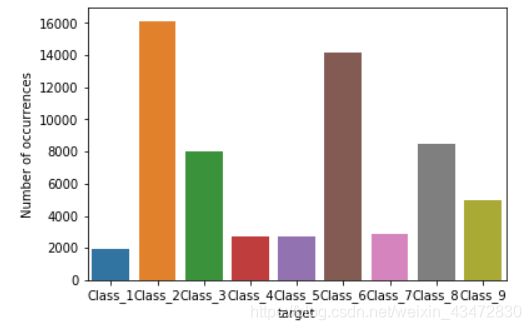Kaggle实战(四): XGBoost调参
以Kaggle 2015年举办的Otto Group Product Classification Challenge竞赛数据为例,进行XGBoost参数调优探索。
竞赛官网:https://www.kaggle.com/c/otto-group-product-classification-challenge/data
# 导入模块,读取数据
from xgboost import XGBClassifier
import xgboost as xgb
import pandas as pd
import numpy as np
from sklearn.model_selection import GridSearchCV
from sklearn.model_selection import StratifiedKFold
from sklearn.metrics import log_loss
from matplotlib import pyplot
import seaborn as sns
%matplotlib inline
dpath = 'F:/Python_demo/XGBoost/data/'
train = pd.read_csv(dpath +"Otto_train.csv")
train.head()1.看样本分布是否均衡
sns.countplot(train.target);
pyplot.xlabel('target');
pyplot.ylabel('Number of occurrences');每类样本分布不是很均匀,所以交叉验证时也考虑各类样本按比例抽取
2. 提取训练和标签
y_train = train['target']
y_train = y_train.map(lambda s: s[6:]) # .map 迭代进行函数计算,提取出对应的标签1,2.3. Class_1中标签1位置为s[6:]
y_train = y_train.map(lambda s: int(s)-1) # 将标签转化为0开始
train = train.drop(["id", "target"], axis=1) # 删除id,target行
X_train = np.array(train) # 输入变量3.设置交叉验证,各类样本不均衡,交叉验证是采用StratifiedKFold,在每折采样时各类样本按比例采样
kfold = StratifiedKFold(n_splits=5, shuffle=True, random_state=3)4. 设置xgboost默认参数,开始对树个数进行调整,
def modelfit(alg, X_train, y_train, useTrainCV=True, cv_folds=None, early_stopping_rounds=50):
if useTrainCV:
xgb_param = alg.get_xgb_params()
xgb_param['num_class'] = 9 # 设置分类类别数目
xgtrain = xgb.DMatrix(X_train, label = y_train) # DMatrix 是 xgb 存储信息的单位,本步骤把数据放进这里面去
cvresult = xgb.cv(xgb_param, xgtrain, num_boost_round=alg.get_params()['n_estimators'], folds =cv_folds,
metrics='mlogloss', early_stopping_rounds=early_stopping_rounds, verbose_eval=10)
# num_boost_round是最大迭代次数,early_stopping_rounds次指标没有提升,输出对应的轮数,verbose_eval次打印一次损失
n_estimators = cvresult.shape[0] # 获取最合适树的个数
alg.set_params(n_estimators = n_estimators) # 设置最佳值
print( cvresult ) # 输出交叉验证信息
#result = pd.DataFrame(cvresult) #cv缺省返回结果为DataFrame
#result.to_csv('my_preds.csv', index_label = 'n_estimators')
cvresult.to_csv('my_preds_4_1.csv', index_label = 'n_estimators') # 保存交叉验证信息
# plot
test_means = cvresult['test-mlogloss-mean']
test_stds = cvresult['test-mlogloss-std']
train_means = cvresult['train-mlogloss-mean']
train_stds = cvresult['train-mlogloss-std']
x_axis = range(0, n_estimators)
pyplot.errorbar(x_axis, test_means, yerr=test_stds ,label='Test')
pyplot.errorbar(x_axis, train_means, yerr=train_stds ,label='Train')
pyplot.title("XGBoost n_estimators vs Log Loss")
pyplot.xlabel( 'n_estimators' )
pyplot.ylabel( 'Log Loss' )
pyplot.savefig( 'n_estimators.png' )
#Fit the algorithm on the data
alg.fit(X_train, y_train, eval_metric='mlogloss') # 训练最佳算法
#Predict training set:
train_predprob = alg.predict_proba(X_train) # 计算训练集正确度
logloss = log_loss(y_train, train_predprob)
#Print model report:
print ("logloss of train :" )
print(logloss)
#params = {"objective": "multi:softprob", "eval_metric":"mlogloss", "num_class": 9}
xgb1 = XGBClassifier(
learning_rate =0.1,
n_estimators=1000, #数值大没关系,cv会自动返回合适的n_estimators
max_depth=5,
min_child_weight=1, # 叶子节点需要的最小样本权重
gamma=0, # 节点分裂所需的最小损失函数下降值
silent=0, # 输出测试信息
subsample=0.3, # 样本采样比
colsample_bytree=0.8, # 特征比例
colsample_bylevel=0.7, # 分裂所需特征比例
objective= 'multi:softprob', # 多分类问题
seed=3)
modelfit(xgb1, X_train, y_train, cv_folds = kfold)5. 调整树的参数:max_depth & min_child_weight
# 采用上面得到的n_estimators最优值(699),其余参数继续默认值
# 设置超参数调整范围:max_depth 建议3-10, min_child_weight=1/sqrt(稀有事件数) =5.5
max_depth = range(3,10,2)
min_child_weight = range(1,6,2)
param_test2_1 = dict(max_depth=max_depth, min_child_weight=min_child_weight)
{'max_depth': range(3, 10, 2), 'min_child_weight': range(1, 6, 2)}
注意:用交叉验证评价模型性能时,用scoring参数定义评价指标。评价指标是越高越好,因此用一些损失函数当评价指标时,需要再加负号,如neg_log_loss,neg_mean_squared_error 详见sklearn文档:http://scikit-learn.org/stable/modules/model_evaluation.html#log-loss
# 使用机器学习算法进行网格搜索
xgb2_1 = XGBClassifier(
learning_rate =0.1,
n_estimators=699, #第一轮参数调整得到的n_estimators最优值
max_depth=5,
min_child_weight=1,
gamma=0,
subsample=0.3,
colsample_bytree=0.8,
colsample_bylevel = 0.7,
objective= 'multi:softprob',
seed=3)
gsearch2_1 = GridSearchCV(xgb2_1, param_grid = param_test2_1, scoring='neg_log_loss',n_jobs=-1, cv=kfold) # param_grid为所调整的参数
# 网格搜索 (分类器,所调整的参数,评价标准,并行, 交叉验证 )
gsearch2_1.fit(X_train , y_train)查看评价指标
gsearch2_1.grid_scores_, gsearch2_1.best_params_, gsearch2_1.best_score_, gsearch2_1.cv_results_
# 不同参数情况下的评价结果,最佳结果的参数的组合,最好的评分,交叉验证结果详细参数,属性设置可见:https://blog.51cto.com/emily18/2088128?utm_source=oschina-app
对验证结果保存并绘制相应图形
# summarize results
print("Best: %f using %s" % (gsearch2_1.best_score_, gsearch2_1.best_params_))
test_means = gsearch2_1.cv_results_[ 'mean_test_score' ]
test_stds = gsearch2_1.cv_results_[ 'std_test_score' ]
train_means = gsearch2_1.cv_results_[ 'mean_train_score' ]
train_stds = gsearch2_1.cv_results_[ 'std_train_score' ]
pd.DataFrame(gsearch2_1.cv_results_).to_csv('my_preds_maxdepth_min_child_weights_1.csv')
# plot results
test_scores = np.array(test_means).reshape(len(max_depth), len(min_child_weight))
train_scores = np.array(train_means).reshape(len(max_depth), len(min_child_weight))
for i, value in enumerate(max_depth):
pyplot.plot(min_child_weight, -test_scores[i], label= 'test_max_depth:' + str(value))
#for i, value in enumerate(min_child_weight):
# pyplot.plot(max_depth, train_scores[i], label= 'train_min_child_weight:' + str(value))
pyplot.legend()
pyplot.xlabel( 'max_depth' )
pyplot.ylabel( 'Log Loss' )
pyplot.savefig('max_depth_vs_min_child_weght_1.png' )6.调整完max_depth & min_child_weight后,再次调整一下弱分类区的数目
7.调整subsample(每棵树所用样本比例) 和 colsample_bytree(每棵树所用特征比例),与调整max_depth & min_child_weight过程类似
subsample = [i/10.0 for i in range(3,9)]
colsample_bytree = [i/10.0 for i in range(6,10)]
param_test3_1 = dict(subsample=subsample, colsample_bytree=colsample_bytree){'colsample_bytree': [0.6, 0.7, 0.8, 0.9],
'subsample': [0.3, 0.4, 0.5, 0.6, 0.7, 0.8]}网格搜索:
xgb3_1 = XGBClassifier(
learning_rate =0.1,
n_estimators=645, #第二轮参数调整得到的n_estimators最优值
max_depth=6,
min_child_weight=4,
gamma=0,
subsample=0.3,
colsample_bytree=0.8,
colsample_bylevel = 0.7,
objective= 'multi:softprob',
seed=3)
gsearch3_1 = GridSearchCV(xgb3_1, param_grid = param_test3_1, scoring='neg_log_loss',n_jobs=-1, cv=kfold)
gsearch3_1.fit(X_train , y_train)
gsearch3_1.grid_scores_, gsearch3_1.best_params_, gsearch3_1.best_score_画出调整过程中的参数
print("Best: %f using %s" % (gsearch3_1.best_score_, gsearch3_1.best_params_))
test_means = gsearch3_1.cv_results_[ 'mean_test_score' ]
test_stds = gsearch3_1.cv_results_[ 'std_test_score' ]
train_means = gsearch3_1.cv_results_[ 'mean_train_score' ]
train_stds = gsearch3_1.cv_results_[ 'std_train_score' ]
pd.DataFrame(gsearch3_1.cv_results_).to_csv('my_preds_subsampleh_colsample_bytree_1.csv')
# plot results
test_scores = np.array(test_means).reshape(len(colsample_bytree), len(subsample))
train_scores = np.array(train_means).reshape(len(colsample_bytree), len(subsample))
for i, value in enumerate(colsample_bytree):
pyplot.plot(subsample, -test_scores[i], label= 'test_colsample_bytree:' + str(value))
#for i, value in enumerate(min_child_weight):
# pyplot.plot(max_depth, train_scores[i], label= 'train_min_child_weight:' + str(value))
pyplot.legend()
pyplot.xlabel( 'subsample' )
pyplot.ylabel( 'Log Loss' )
pyplot.savefig( 'subsample_vs_colsample_bytree1.png' )Best: -1.813067 using {'subsample': 0.8, 'colsample_bytree': 0.9}8.调整正则化参数:reg_alpha(L1/L0正则的惩罚系数)和reg_lambda(L2正则惩罚系数)
reg_alpha = [ 1.5, 2] #default = 0, 测试0.1,1,1.5,2
reg_lambda = [0.5, 1, 2] #default = 1,测试0.1, 0.5, 1,2
param_test5_1 = dict(reg_alpha=reg_alpha, reg_lambda=reg_lambda)
xgb5_1 = XGBClassifier(
learning_rate =0.1,
n_estimators=645, #第二轮参数调整得到的n_estimators最优值
max_depth=6,
min_child_weight=4,
gamma=0,
subsample=0.7,
colsample_bytree=0.6,
colsample_bylevel = 0.7,
objective= 'multi:softprob',
seed=3)
gsearch5_1 = GridSearchCV(xgb5_1, param_grid = param_test5_1, scoring='neg_log_loss',n_jobs=-1, cv=kfold)
gsearch5_1.fit(X_train , y_train)
# summarize results
print("Best: %f using %s" % (gsearch5_1.best_score_, gsearch5_1.best_params_))
test_means = gsearch5_1.cv_results_[ 'mean_test_score' ]
test_stds = gsearch5_1.cv_results_[ 'std_test_score' ]
train_means = gsearch5_1.cv_results_[ 'mean_train_score' ]
train_stds = gsearch5_1.cv_results_[ 'std_train_score' ]
pd.DataFrame(gsearch5_1.cv_results_).to_csv('my_preds_reg_alpha_reg_lambda_1.csv')
# plot results
test_scores = np.array(test_means).reshape(len(reg_alpha), len(reg_lambda))
train_scores = np.array(train_means).reshape(len(reg_alpha), len(reg_lambda))
#log_reg_alpha = [0,0,0,0]
#for index in range(len(reg_alpha)):
# log_reg_alpha[index] = math.log10(reg_alpha[index])
for i, value in enumerate(reg_alpha):
pyplot.plot(reg_lambda, -test_scores[i], label= 'reg_alpha:' + str(value))
#for i, value in enumerate(min_child_weight):
# pyplot.plot(max_depth, train_scores[i], label= 'train_min_child_weight:' + str(value))
pyplot.legend()
pyplot.xlabel( 'reg_alpha' )
pyplot.ylabel( '-Log Loss' )
pyplot.savefig( 'reg_alpha_vs_reg_lambda1.png' )9.最后再次调整弱分类器的数目


